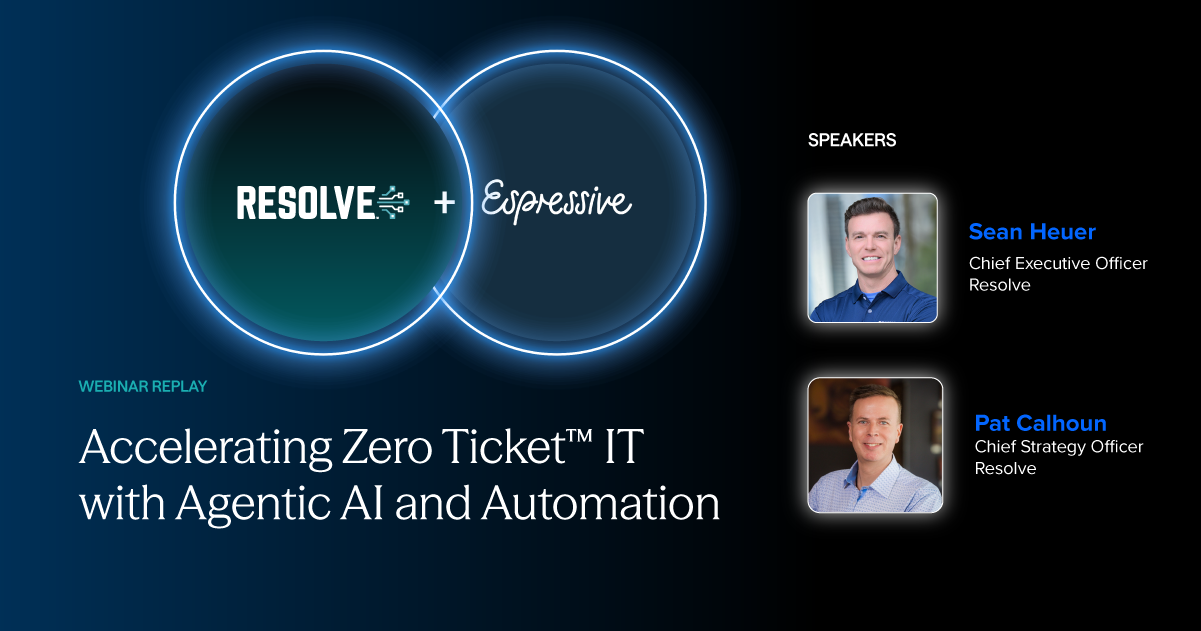
Top 5 Financial Services Trends IT Leaders Must Know to Accelerate Digital Transformation
Subscribe to receive the latest content and invites to your inbox.
We could probably sum up the direction the financial services industry is headed in just two words: digital transformation.
It's the buzzy, all-encompassing focus and end goal of financial services organizations near and far, and it's the big reason why many organizations are thinking about process automation with a greater sense of urgency.
Accelerating digital transformation goals requires companies to innovate and take bold moves beyond those of their competitors—think strategic automation that enables maximum modernization. Digital transformation might seem a bit difficult to achieve, but the missing piece of process automation brings is well within reach
Financial services as a whole is gaining complexity, and so business processes must be mapped out and defined, and orchestrated along any digital transformation journey. As IT is the core of driving business goals, it must be open to change and embrace the latest advancements in technology. Artificial intelligence (AI) is growing as a huge, transformative force in the banking world with technologies we've never seen before. A landscape like this means there's no limit to what innovative IT automation can do.
The future of financial services is expected to follow five main trends that IT leaders will have to not only be hyper-aware of, but fully embrace. Without further ado, these trends include:
1. Digitization and Financial Technology
Organizations today must transform into technology-driven companies, which means going digital to the core—from the bottom to the top. While digitization efforts come from and apply to the company as a whole, it starts in IT.
Fintech companies, those that rely heavily on technology, are multiplying and becoming more powerful thanks to innovative advancements. As such, C-suite executives and leadership are working to increase their agility and become more tech-savvy by getting rid of old work method patterns, upskilling themselves and their teams, and ultimately—reimagining the digital business.
Even if it's a small one, leaders are starting their digital transformation journeys sooner rather than later to prevent their company operations from being outdated and falling behind their competitors.
The sense of urgency and hunger for digital transformation is real. A KPMG study found 47 percent of financial services providers expected to see revolutionary digital transformation by 2023, and 53 percent believe more than 10 percent of their workforce will be automated and replaced by superior technology by 2025.
Additionally, EY research revealed in 2021 that 92 percent of finance leaders (across 89 corporates) had started their journey to introduce digital interventions in the finance function, but only 11 percent believed they were at an advanced stage.
2. Automation and Orchestration
Uniting the old and the new, and swift adoption of automation are two key prerequisites for providing support for digitization of core banking. Delays pose too much risk of becoming outdated.
IT leaders who successfully back business priorities have a real appetite for orchestration of automated processes—a more coordinated method of stitching together siloed and disjointed workflows.
Advancements in self-service tools and automated fulfillment have transformed every aspect of the financial industry landscape. They've made it easier to mitigate fraud and money laundering risks, and they've enabled faster and smarter trade decisions based on sharper analyses of past market performance data. Because of self-service tools like chatbots, automated processes can significantly increase operational efficiencies.
Bank of America's virtual assistant Erica, for example, demonstrated the value of chatbots in customer engagement, reaching nearly 32 million clients and surpassing 1 billion interactions. Bank of America says Erica allows a seamless user experience and personalization, allowing for quick response to voice, text chat, or on-screen interactions, as well as fast assistance with financial transactions and personalized insights when it matters most for clients.
Robotic Process Automation (RPA): A Good Starting Point
About 80 percent of finance leaders have already implemented or are planning to implement RPA to augment the digital potential of their businesses, though adoption of new digital technologies and cloud is still quite challenging. Gartner says there's plenty of pressure to increase the return on investment (ROI) of RPA for financial services and at the same time, RPA must be scaled out of shared services and into other finance functions like procurement and tax.
Full process automation helps improve the accuracy of financial analysis and forecasts. And a blend is best: RPA paired with other intelligent automation technologies drives better efficiency, greater compliance, and increased productivity.
3. Digital Currencies
The Federal Reserve issued a report earlier this year that Central Bank Digital Currency (CBDC) could fundamentally change the structure of the U.S. financial system.
So how would it work?
CBDC would basically act just like actual cash. The recipient of CBDC would have the equivalent of physical money secured in “an account” that belonged to them. But not in the same sense as PayPal, for example. PayPal indicates that money is coming and moving from account to account, but with CBDC, funds would already be there through an irrevocable transaction.
Forbes says a key advantage of CBDC is that it could be deemed legal tender, meaning all economic actors must accept it for all legal purposes. People could use CBDC to pay taxes, for instance, and anyone who lends money would be legally required to accept it for repayment. CBDC is different from cryptocurrency, as it must be converted into U.S. dollars before it's used.
As with many newer digital rollouts, CBDC comes with a few challenges to figure out:
- Volatility and Regulation: When people think of digital currencies, they often envision a high price volatility and therefore, mainstream adoption slows. Regulatory frameworks can help balance the need to protect customers and support digital currency innovation.
- Scalability and Energy Consumption: Digital currencies are growing in popularity and this trend raises concerns about scalability and energy consumption. Current infrastructures run into limits when processing large counts of transactions, and as for energy requirements, their requirements for mining operations bring about environmental worries.
- Security and Fraud: Digital currencies do provide enhanced security features, but nothing is completely immune to attacks. Robust security measures to keep customer assets safe, as well as ensure trust in digital currencies, must keep pace with technological advancements and evolutions.
What's Up Next for Digital Payments?
Consumer payments in-store and online call for constant technological innovation. In fact, Peer-to-Peer (P2P) mobile transaction users are predicted to reach just under 148 billion in 2023. Those that provide P2P mobile payments today are in primetime to increase revenue for the business.
Industry changes are strongly suggested as digital payments allow for easier cross-boarder payments and real-time cardless payments.
Additionally, the digital payment landscape looks to include continuous debit card usage while financial instability lingers, increasingly competitive credit card perks that motivate spending, and the growth of Buy Now, Pay Later (BNPL) that incentivizes spending.
IT leaders will need to evolve at the same pace, if not ahead, of new forms of digital payments as they introduce themselves and expand among users. It'll take modern applications built using next-generation technology and standing up reliable and secure infrastructure to accomplish the fast builds and ensure business continuity.
For today and the foreseeable future, there's still come coexistence. IT teams will continue to support some traditional forms of payments along with newer, digital currencies. And they'll have to do so in a way that ensures progress without disrupting IT operations that support existing payment processing.
4. Customer Centricity
Supporters of innovative digital finance technology say advancements like CBDCs are the answer to greater efficiency, stronger security, and facilitated access, among others.
According to McKinsey & Company, CBDCs and digital financial services offer the following benefits as they pertain to the increasing focus on customer service and meeting users where they are:
- Reduced Costs: Financial service providers can clinch a savings of $400 billion annually in direct costs, just by shifting toward digital finance and away from physical infrastructure. It's important to note; however, that reduced costs must be measured against investments that come when acquiring new technology, CBDCs included.
- Faster Speed: As touched on above, CBDCs have the ability to increase the speed and improve the efficiency of electronic payment systems in handfuls of countries. IT teams will have to develop infrastructure for digital currencies even faster than before.
- More Access for People Without Bank Accounts: No account? No problem. Through increased financial inclusion—which joins those with bank accounts and those without—CBDCs will become more accessible. As such, digital finance providers will have a new gateway into untouched markets—consumers who manage banking on their own and who even prefer anonymity from banking companies.
- Heightened Security: McKinsey says deploying a regulated digital currency accessible via mobile devices could enhance payment security by making sure transactions are final and unalterable, even without an official bank account, and could reduce the risk of fraud. Users can e-sign transactions via regulated private-key cryptography, enabling faster finalization of transactions and enhanced user satisfaction.
IT in the Driver's Seat for Customer-centric Change
IT is the foundational core that can remove—if not prevent—any friction from the customer experience. IT leaders are the powerful force behind customer-centric transformations, providing three key abilities:
- Understand customer needs, behaviors, and values before digitization projects begin, so as to streamline the way customers connect with digital products.
- Review transformations against customer centric KPIs. Combine the net promoter score (NPS) with other metrics, like a customer's interaction with a digital product.
- Create a culture of customer centricity wherein every IT employee embraces its importance and aims to improve it.
And IT has an even bigger role that mustn't be forgotten: They're essential for supporting the digital payments and digital currencies that advance society as a whole. Millions of people are already making payments, transferring funds, and investing at a massive scale—all via digital means rather than with dollars.
5. Security
Ransomware and malware: Two words that make financial services organizations shutter. After all, they're both on the rise and exploit vulnerability at its finest. When it comes to human error, IT professionals know one wrong click can cause forever-damaging data and security breaches, and it can happen within a second or two.
In one year, from 2021-2022, 55 percent of financial institutions were impacted by ransomware. That stat reflects a notable 62 percent increase from the previous year. Financial institutions received some of the lowest-ever payouts from insurance companies following breaches, making the need for greater defense clear.
It's a call for automation that can't be ignored, as financial services organizations face lack of available human talent.
The shortage hinders, if not blocks, business' abilities to manage in-house needs, especially considering the need for new talent to understand them up front. And even when organizations acquire new IT employees, they can fail to provide enough training, consistently, on how to identify potential attack vectors. Automation in these instances ensures consistency and addresses issues caused by human error.
Automation enables IT staff to upskill as well, increasing their motivation at work and locking in their invaluable loyalty to the company. What it comes down to is this: Businesses looking to truly reach digital transformation need to also digitally transform their operations and build a strong defense.
The Future of Cybersecurity in Financial Services
In a world forever-changed by the pandemic, the digitalization of operational, distribution, and customer engagement processes are here to stay, Deloitte reports, finding that endpoint detection and response (EDR) and security monitoring to detect cyberthreats no longer cut it.
Aggressively monitoring access controls and setting in motion an ongoing cycle of employee awareness training and compliance tracking (no matter where they work) aren't negotiable.
Deloitte's survey revealed data management and perimeter protection as the biggest security challenges organizations face. And as legacy systems age and get closer to retirement, IT departments must operate across silos—no longer in them.
The future holds the critical space for IT departments to further mature their infrastructures as the financial services industry moves to virtualize the workforce and revamp legacy cybersecurity infrastructures.
The importance of digital transformation and modernization in banking and financial services is paramount—highlighting the power of IT automation and orchestration to keep organizations ahead of innovation and new technologies.
The financial services landscape's nonstop shifts and advancements create a larger-than-life need for automation for picture-perfect customer experiences, operational efficacy and resiliency, and robust risk management. Watch our webinar replay to learn more: "Mastering Modernization: Automation Tips for Financial Services to Digitize Core Processes."






